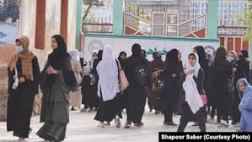Education in the shadow of the Taliban government

The educational system (ma’arif) in Afghanistan has faced fundamental changes under the rule of the Taliban. These changes have had a significant impact on students, especially girls, both in terms of educational policies and social and cultural restrictions. Some of the challenges and the state of education in the shadow of the Taliban government are as follows:
-
Educational restrictions for girls
One of the biggest changes after the Taliban came to power was the severe restrictions on girls’ education. From the beginning of their rule, the Taliban closed secondary and high schools for girls above the sixth grade in most parts of the country. With this action, millions of Afghan girls were deprived of education and their right to continue their education was under severe pressure. -
extreme gender segregation
In the schools that are still active, strict gender segregation is enforced. The classrooms for boys and girls are completely separated, and in some cases, different hours are set for boys and girls to attend school. Female teachers are also limited to teach girls, and the Taliban have banned men from teaching girls. -
Change in educational content
Taliban have tried to change the educational content of schools according to their thoughts and ideology. In this regard, religious subjects and Islamic studies have been strengthened in the school curriculum, while some modern subjects have either been reduced or completely eliminated. The Taliban place special emphasis on Islamic Sharia education, and this issue has reduced the quality and extent of scientific education. -
Financial problems and reduction of international support
With the Taliban coming to power, many international organizations that were working to support education in Afghanistan have stopped or drastically reduced their aid. This issue has reduced the educational budget and caused problems such as lack of educational equipment, textbooks, and teachers’ salaries. Many teachers work unpaid or underpaid.

-
Effect of poverty and insecurity
The widespread poverty and unemployment in Afghanistan under the Taliban rule has also had a negative impact on education. Many families are unable to send their children to school due to financial problems and have to send their children to work. Also, insecurity in some areas has caused schools to be closed or students and teachers do not dare to attend them. -
Restriction in higher education
Restrictions are not limited to schools. Universities have also faced new and strict rules. Girls are not allowed to study in many fields and they are required to observe gender segregation in universities. This has reduced the number of girls who can access higher education. -
Lack of equal pay for female teachers
Female teachers have also faced many occupational and social restrictions under the Taliban regime. Their salaries and status have been greatly reduced and in many areas they have even been banned from teaching. This has caused the lack of teachers in many schools, especially girls’ schools, to become a major problem. -
Focus on religious education
The Taliban place great emphasis on religious education and Islamic teachings. Religious schools or schools under the supervision of the Taliban mostly teach the Quran, Hadith and Islamic jurisprudence, and they have proposed religious sciences as the main part of education in public and private schools. This type of education may prevent students from learning modern and applied sciences. -
violation of children’s rights
Deprivation of education is a violation of children’s fundamental rights. Human rights organizations have repeatedly emphasized that the right to education should be guaranteed for all children, regardless of gender. But in the current situation, many children, especially girls, have been deprived of this right, and their educational and career futures are in danger.
Conclusion
The education system in Afghanistan under the rule of the Taliban has faced great problems and challenges. From the restrictions on girls’ education to the changes in the curriculum and the reduction of international support, all of them have caused the future of the education system in Afghanistan to be uncertain and worrisome. To improve the state of education, there is a need for fundamental changes and removing restrictions, especially for girls and women.